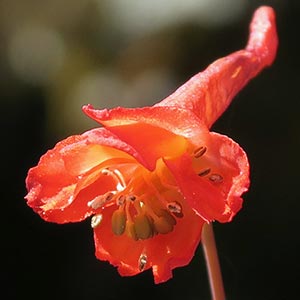Delphinium nudicaule
Delphinium cardinale
canyon delphinium, canyon larkspur, orange larkspur, red larkspur, red or orange larkspur, scarlet larkspur
cardinal larkspur, cardinal or scarlet larkspur, scarlet larkspur
(15-)20-50(-125) cm;
base reddish, glabrous.
(33-)50-150(-280) cm;
base reddish, ± puberulent.
blade round to pentagonal, 2-6 × 3-10 cm; ultimate lobes 3-12, width 5-40 mm (basal), 2-20 mm (cauline).
blade round to reniform, 3-7 × 5-10 cm, nearly glabrous; ultimate lobes 0-27, width 5-40 mm (basal), 0.5-6 mm (cauline).
5-20(-69)-flowered;
pedicel (1.5-)2-6(-8) cm, glabrous to glandular-pubescent;
bracteoles 14-20(-30) mm from flowers, green to red, linear, 2-4(-9) mm, glabrous to puberulent.
10-40(-80)-flowered, open, narrowly pyramidal;
pedicel spreading, (1-)2-5 cm, ± puberulent;
bracteoles (2-)7-15(-25) mm from flowers, green, linear, 3-7 mm, glabrous to puberulent.
sepals scarlet to reddish orange, rarely dull yellow, glabrous, lateral sepals forward-pointing to form pseudotube, (6-)8-13(-16) × 3-6 mm, spurs straight, slightly ascending, (12-)18-27(-34) mm;
lower petal blades elevated, exposing stamens, 2-3 mm, clefts 0.5-1 mm;
hairs sparse, evenly dispersed, yellow.
sepals red, glabrous, lateral sepals forward pointing, 11-15 × 5-8 mm, spurs straight, stout, slightly ascending, 15-24 mm;
lower petal blades nearly coplanar with claw, exposing stamens, 2-5 mm, clefts 0.5-1.5 mm;
hairs centered at base of cleft, short, sparse, yellow.
13-26 mm, 3.5-4.5 times longer than wide, glabrous.
erect, 9-18 mm, 2.5-4 times longer than wide, glabrous.
unwinged or sometimes slightly wing-margined;
seed coat cells with surfaces smooth.
unwinged;
seed coat cells with margins undulate, surfaces roughened.
= 16.
= 16.
Delphinium nudicaule
Delphinium cardinale
Delphinium nudicaule hybridizes with most other taxa of Delphinium that it encounters. Apparent hybrids involving D. nudicaule, and seen by the author (either afield or as specimens), include D. andersonii, D. antoninum, D. decorum, D. luteum, D. nuttallianum, D. patens, and D. trolliifolium. In addition, garden-grown plants have been hybridized with D. cardinale, D. elatum, D. menziesii, D. parishii, D. penardii, D. tatsienense Franchet, D. triste Fischer ex de Candolle, and D. uliginosum; D. nudicaule does not naturally occur with these species. Delphinium nudicaule is one of the earliest larkspurs to flower in any given locality. Douglas's type collection of D. nudicaule represents plants (synonyms D. sarcophyllum Hooker & Arnott and D. peltatum Hooker, an invalid name) grown under very moist conditions, probably quite near the ocean. The type specimen of D. armeniacum A. Heller represents plants grown under unusually dry conditions.
The Mendocino Indians consider Delphinium nudicaule a narcotic (D. E. Moerman 1986).
(Discussion copyrighted by Flora of North America; reprinted with permission.)
Hybrids between Delphinium cardinale and D. parryi have been named D. ×inflexum Davidson. Because of horticultural interest in red-flowered delphiniums, garden hybrids have been made with D. elatum, D. hesperium, D. hutchinsoniae, D. nudicaule, D. parishii, D. penardii, D. scopulorum, D. tatsienense Franchet, D. uliginosum, and D. zalil Aitchison & Hemsley, although D. cardinale does not grow with any of these in the wild.
Plants of Delphinium cardinale are quite variable in size, leaf distribution, and pubescence, resulting in considerable differences between, and sometimes within, populations. No patterns could be seen, however, to justify recognition of separate taxa within D. cardinale. Populations farther south (in Baja California, Mexico) may represent a distinct entity; they require further study.
The only possible confusion between Delphinium cardinale (seeds not ringed, fruits erect, grows in relatively dry sites) and another taxon might occur with Delphinium nudicaule (seeds ringed, fruits spreading, grows in moist habitats). The two are separated geographically and phenologically (although D. cardinale may begin flowering in southern California before D. nudicaule has finished in northern California).
(Discussion copyrighted by Flora of North America; reprinted with permission.)


